

The expansion makes a lot of changes and improvements to the standard game, adding new civs, wonders, governments, units, and so on. But while this is all well and good, the main selling point of the game is probably the nine Conquests scenarios, each of which is practically a game unto itself. There's a lot of speculation about the scenarios out there, and a great deal of misinformation floating around on Internet bulletin boards, so I will try and provide a basic description of what each one entails here and illustrate them with some nice pictures. With any luck, at least one of these scenarios will appeal to you, and this goes double for history buffs who already know about the historical periods.
Introductory Conquest #1: Ancient Treasures
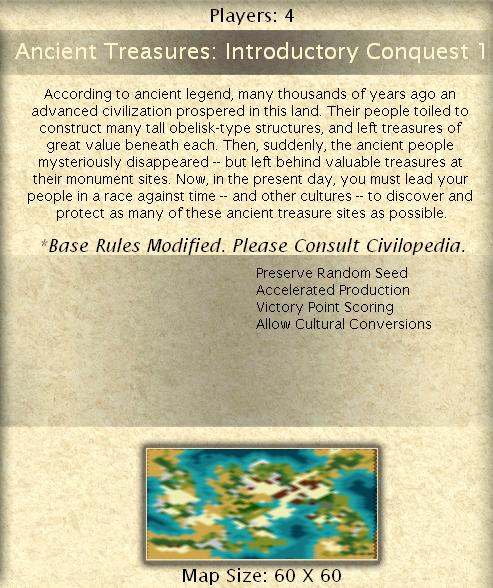 |
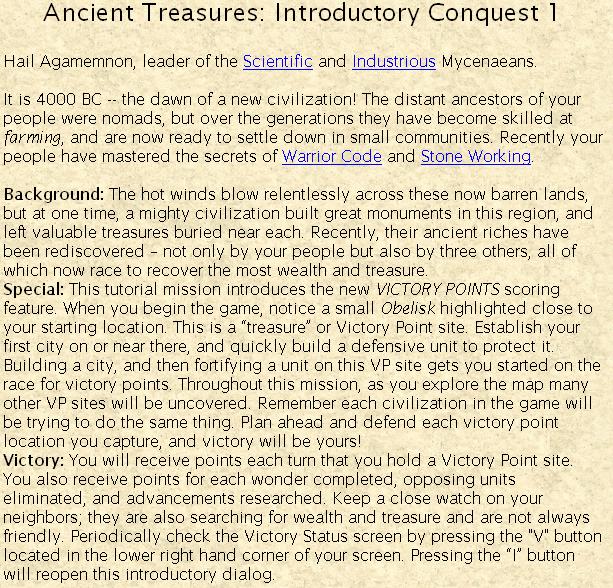 |
This is actually not one of the nine Conquests. The expansion also includes three introductory tutorials designed to help new players get accustomed to the game. That doesn't mean that they are only for newbies, of course; each one can also be played on all eight difficulties right up to Sid itself. Ancient Treasures is based around finding and securing victory point locations, which are scattered across the map. The game has accelerated production on and uses a tiny map, so contact will be fast and combat soon in coming. You have a choice of four civs: Egypt, Sumer, Mycenae, and the Hittites; these civs do NOT have the same civ traits as in the standard game (and this generally holds true for all of the scenarios). Like many of the Conquests scenarios, this one uses the concept of "victory points", something introduced in PTW but pretty much never used until now. You amass victory points in a couple of different ways, by having a victory point location within your cultural borders, by building great wonders, by killing enemy units, and by capturing enemy cities. In this particular scenario, victory point locations provide by far the most points. Ancient Treasures has a limit of 120 turns; at that point, the civ with the highest victory point total is the winner. You can also win by being the first one to 30,000 victory points or (of course) by killing all the other civs. As with all the scenarios, Ancient Treasures has a completely different tech tree to follow; just to give you an indication of its size, there are 45 techs across three "ages" to research, though most games won't discover that many. (This is actually the tech tree from the Mesopotamia Conquest, for the curious.) This game is usually a frantic rush to find and secure victory point locations before time runs out, with lots of combat on all sides. I am also told it makes an excellent multiplayer scenario, since it can be played to completion in about 2-3 hours. I haven't played a full game of this scenario yet, but it is one I plan to try in the future.
Introductory Conquest #2: The Three Sisters
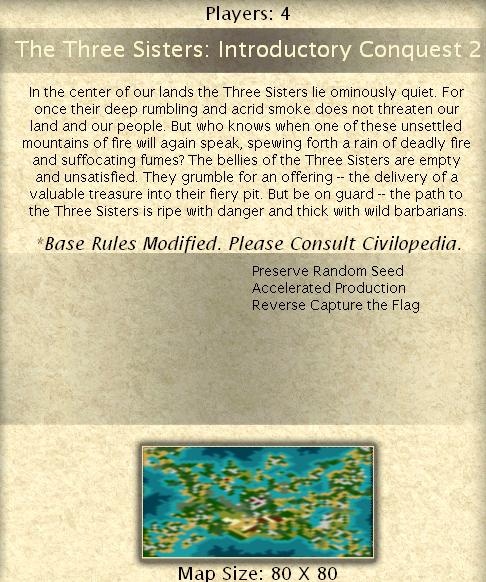 |
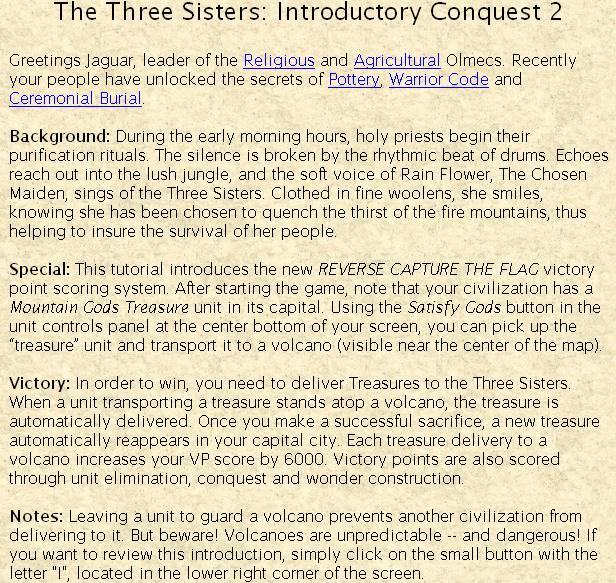 |
This is the second of the three introductory scenarios included. This game also involves victory point scoring, only instead of seeking out victory point locations, the goal is to use the "reverse capture the flag" option to deliver a treasure to a set location on the map. Killing enemy units, capturing enemy cities, and building wonders also again provide victory points. The terrain itself is very rugged, with lots of mountains and volcanos to work with. Play is against split between four civs, with you having your pick of the Aztecs, Olmecs, Inca, and Maya. Since the other civs are also strugging to return their own treasure to the volcano in the middle of the map, combat for control of the center is pretty much inevitable. Don't play this scenario if you are interested in diplomacy, in other words. This game also has a time limit of 125 turns, and can be won by securing 30,000 victory points. Since returning the treasure unit only gets you 6000 points, you'll either have to return multiple units or get points through other means. The Three Sisters also has its own tech tree, which happens to be the same as one used in the Mesoamerica Conquest. From what I heard, this was one of the most popular multiplayer scenarios and can also be played in a short period of time. Oh, and don't forget about the endemic barbarians roaming around the center of the map - you didn't think it would be THAT easy to return a treasure unit, did you?
Introductory Conquest #3: New Alliances
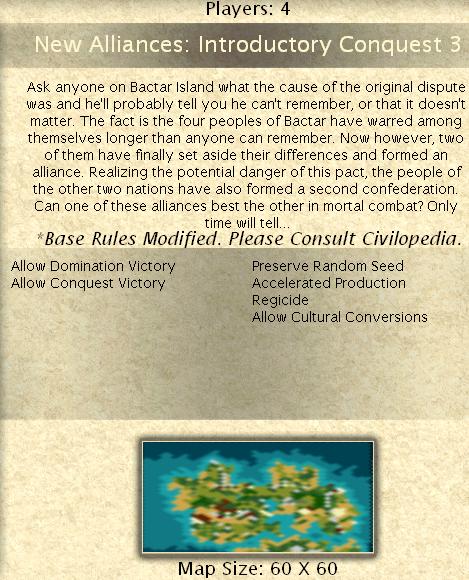 |
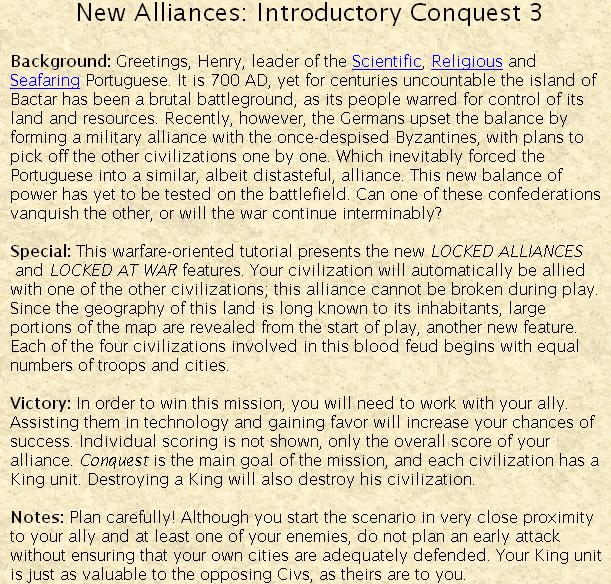 |
Of the three introductory scenarios, this is in my opinion the most interesting one. The key feature is a locked alliance between two pairs of civs, which means that you must remain permanently at war with two of the four civs with the other one as your ally. You have your pick of Germany, Byzantines (who are locked together in one alliance), or Portugal and the Netherlands (who are locked in the other alliance). Victory point scoring is not on, and the goal of the game is to win a domination or conquest victory. Score is calculated by alliance, not by individual civ, and both sides start with exactly equal units at the outset of the game, so you'll have to work together with the other partner to succeed. The tech tree for this scenario is not unique; it uses the tree from standard Civ3 and places you right at the beginning of the Middle Ages with all of the Ancient Age techs completed. Also of note is the fact that this is a Regicide scenario; every civ has one king unit, which causes you to lose the game if it is killed. Obviously that unit has to be protected at all costs, and you will probably have to make efforts to guard your partner's king as well. The game ends after 100 turns, so the early game efforts will be critical to success. While I have not tried it personally, I think this has the potential to be a fabulous multiplayer scenario, and will definitely be soliciting players in the future for just such an effort.
Conquest #1: Mesopotamia
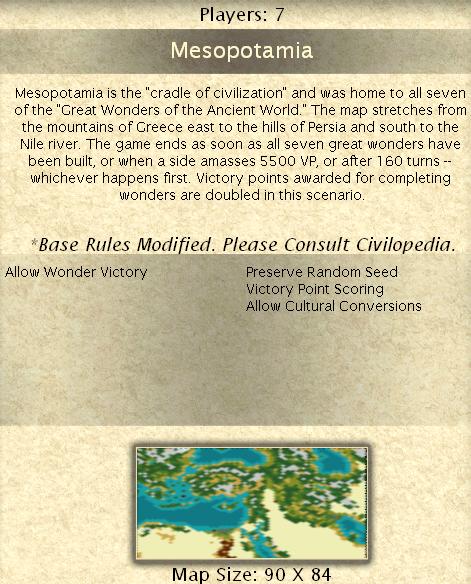 |
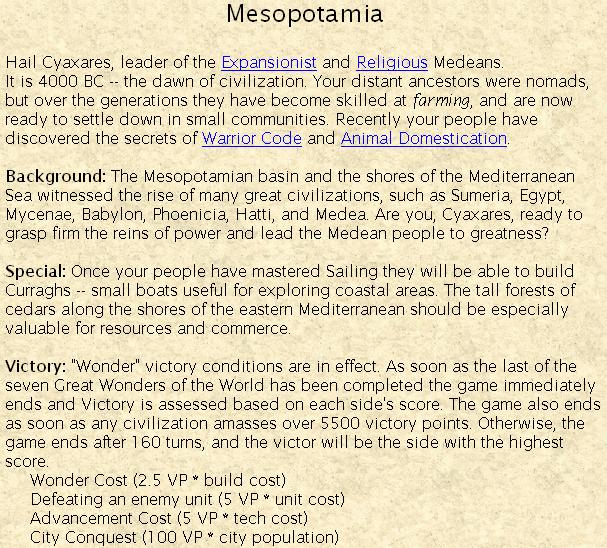 |
The first Conquest scenario is set in ancient Mesopotamia, and is essentially a race to see who can build the most wonders before time runs out. You have your pick from the civs Egypt, Mycenae, Babylon, Medes, Phoenicia, Sumeria, and the Hittites - all of which are placed in their historical location on the map. The tech tree for this game is very, very different from the standard game; it focuses on the Ancient Age and requires you to research some very basic things which one normally starts with. For example, you have to research the ability to irrigate and mine with workers, and cattle don't appear on the map until you research the "Animal Domestification" tech. Trust me, this scenario really has an "ancient" feel to it. As far as scoring is concerned, victory points are used to determine the winner. As usual, you get points for killing units, capturing cities, or building wonders - but in this scenario, the points for wonders are greatly increased to emphasize their importance. Many of the wonders also have resource requirements which don't exist in the standard game, like needing the resource "stone" to build the Pyramids. And of course these civs have their own unique units, like the Tyrian Guard for the Phoenicians (though it uses the Numidian Mercenary graphic). Finally, this scenario has the "wonder victory" condition enabled, which means that the game immediately ends when all 7 wonders of the ancient world are built. At that time, the civ with the highest victory point total is declared the winner (if all the wonders are not built, the game ends after 160 turns anyway). This scenario really focuses around building wonders, so if that's your favorite part of Civ3, this one should be right up your alley. Of course, you can always stick it to the other civs too, but the scenario really isn't designed for that. For the same reason, this is not a very good Conquest for multiplayer; it's meant to be played as versus the computer. Of all the Conquests, this one is generally the most peaceful and involves the most building.
Conquest #2: Rise of Rome
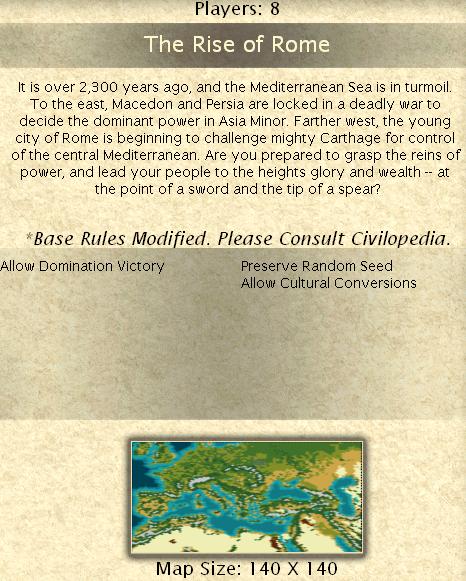 |
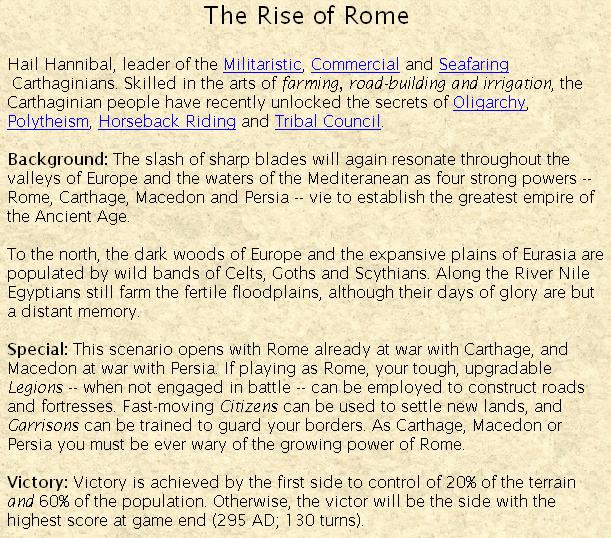 |
I know quite a bit about the Rise of Rome Conquest, since I tested it and made a number of suggestions on how to improve it. This scenario is really all about Rome; the other civs are there to make it entertaining and can certainly be played, but the Romans get most of the special stuff. You have your choice of playing as Rome, Carthage, Macedon, or Persia; there are also four small non-playable civs which can affect the game (Egypt and three "barbarian" civs: the Celts, Teutons, and Scythians). The game focuses around two locked alliances: Rome is permanently locked into war with Carthage, and Macedon into war with Persia. At the start of the game, Rome has by far the least territory but also has by far the strongest unique units. Their legions can be upgraded through three different levels as more techs are researched until they have the highest attack and defense of any unit in this scenario. Speaking of the tech tree, this scenario also has its own customized tech tree, although there is not much of an emphasis in general on research here. The goal is to defeat your permanent enemy and achieve a domination victory; if no one achieves domination, then the civ with the highest score at game's end (turn 130) is the winner. Generally speaking, this is a warring scenario, althoug since the map is so big and so empty, there is plenty of room to expand as well. If you happen to be a fan of Roman history, this scenario has a good chance to appeal to you. The size of the map makes this play like a huge map game, so if you want an epic struggle for control of the ancient Mediterranean, here you are. Could make for a good multiplayer game with four people, but you're going to need a lot of time to play it through to completion. If you want to know more about this scenario, read my testing report on this Conquest listed earlier on the main page.
Conquest #3: Fall of Rome
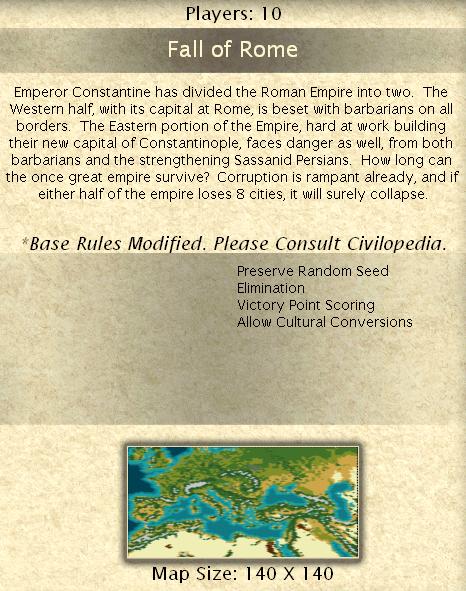 |
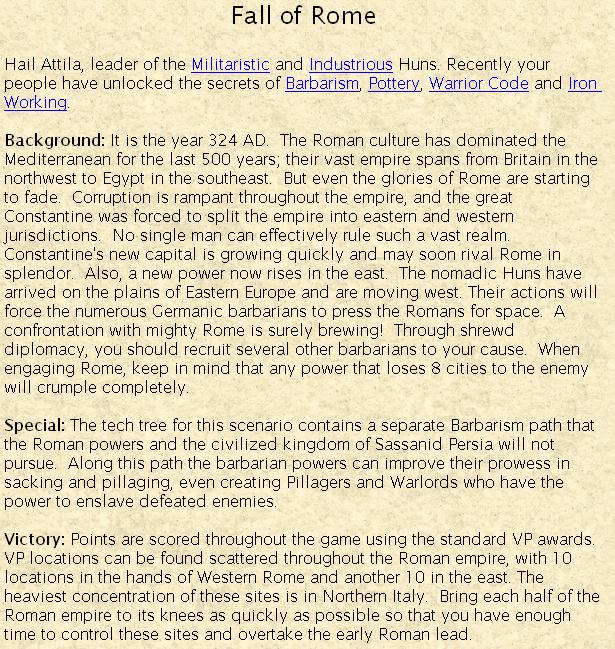 |
This is one of odder Conquest scenarios, and probably one of my least favorites. This game is based around the "Elimination" feature which was added in PTW but which virtually no one ever used. To put it simply, as soon as a civ loses 8 cities, it is utterly destroyed. For a somewhat paranoid player like me, this is not easy on the nerves. Your goal is to play as one of the "barbarian" civs which helped to bring about the downfall of the Roman Empire and fight for control of victory locations sprinkled across the Mediterranean (the base map is the same as for the Rise of Rome scenario, but units and cities are very different). You pick your civ from among the Anglo-Saxons, Ostrogoths, Franks, Sassanids, Huns, Visigoths, Celts, or Vandals. Inexplicably, the East and West Romans (two different civs) are not playable by humans (huh?) The goal is to build up your invading band of barbarians and take control of the victory point locations inside Roman territory, then hold them as long as possible to gain victory points. You also get victory points for unit kills and city captures, of course, and it's also quite likely that the barbarian civs will end up fighting one another at some point in time... This is usually a pretty chaotic scenario, with large parts of the map all but empty and units roaming all over the place. There is a unique tech tree for this scenario as well, though the focus is again not really on researching except for the barbs to get to better marauding units. If you enjoy wanton destruction, this is probably the Conquest for you. It's just a little too disorganized for my personal tastes, but don't let that stop you. Also, be sure to check out the Civilopedia entries for the Anglo-Saxons, Huns, Ostrogoths, Visigoths, and Vandals - I wrote all of them. :)
Conquest #4: Middle Ages
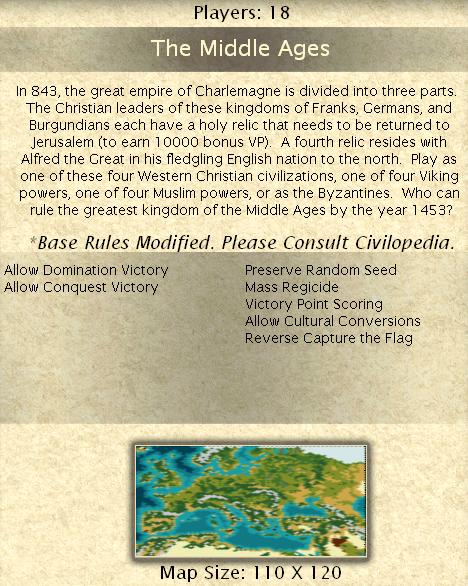 |
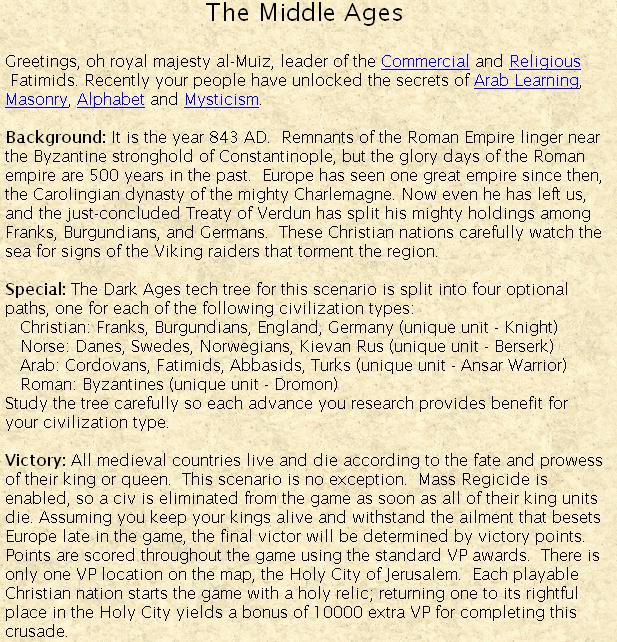 |
This was another scenario that I helped test, so if you want more information I would suggest you read my testing report on it listed earlier on this website. The Middle Ages is possibly the largest and longest of the Conquests, with only the Sengoku scenario rivalling it in size and number of civs. You have your choice between 12 different civs to start, each of which can be divided into one of four cultural groups. These include the Western Christian civs (England, France, Germany, and Burgundy), the Viking civs (Denmark, Norway, Sweden and Kievan Rus), the Arab civs (the Fatimids, Abbasids, Ottoman Turks, and Cordoba), and the Byzantines, who are their own cultural group. Each one of these cultural groups has their own unique unit and their own techs to research, making use of the new "flavors" aspect of Conquests. Each cultural group can research techs from one ofthe other groups, but they are more expensive and the first tech on each branch cannot be traded for; it must be self-researched. The tree itself is very large, spanning three ages and having about 35 techs to research (though many of them are optional). The map is again very large; in addition to the 13 playable civs, there are also 5 more non-playable civs like Castille and the Bulgars to deal with. The scenario is also a mass regicide one, with each playable civ possessing three king unit and the non-playable ones having two king units. Just like with a regicide game, if you lose them all your civ collapses into dust. Scoring is determined by victory points, with points being awarded for the usual feats of killing units, capturing cities, and building wonders. The Western Christian civs also have a special way to gain a bonus 10,000 points by returning their holy relic to Jerusalem (using the reverse capture the flag feature) where the game's only victory point location is situated. This is a massive undetaking from Western Europe and requires a lot of effort to carry out, trust me. In addition to a crusade feature, this scenario also includes a plague to simulate the Black Death which strikes in the 14th century and can cause substantial loss of units and population (it will not kill your king units though). This Conquest takes a very long time to play, but it can be very rewarding for the same reason. It is not a game to undertake lightly, and for that reason doesn't make a very good multiplayer venture. There's a lot here to discover in this scenario, certainly more than I can describe; I just hope to have given a general impression of what is out there.
Conquest #5: Mesoamerica
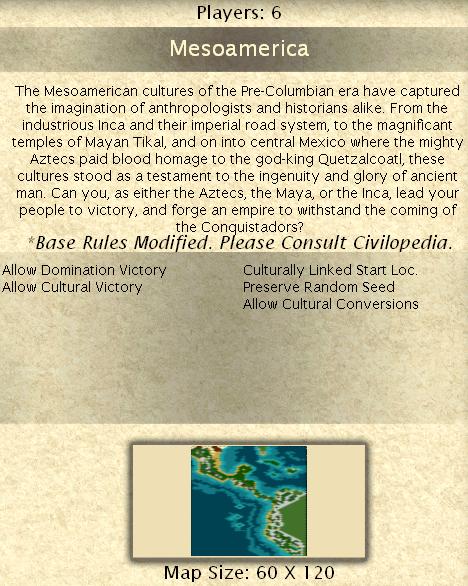 |
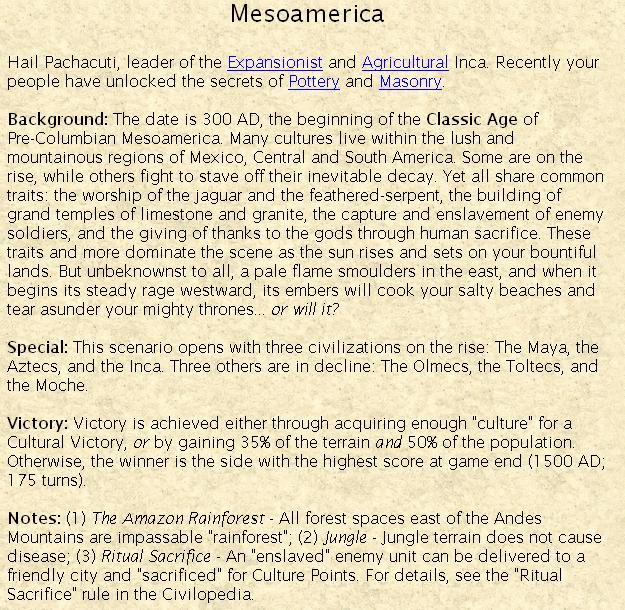 |
For the curious, Mesoamerica refers to the civilizations located in the Americas before the discovery of the New World by Columbus. This was possibly the most popular scenario among the beta testers, and for good reason: who wouldn't enjoy a game in which the goal revolves around enslaving and sacrificing workers to your tribal gods? You have your choice of three civs in this Conquest: the Aztecs, Maya, and Inca. There are also three non-playable civs (the Moche, Olmecs, and Toltecs) which are essentially there for you to beat up upon and take their units as slaves. And enslavement is a HUGE part of this scenario; many of the units have it, and the game revolves around sacrificing enslaved workers in order to produce culture. It's possible to win a domination victory, of course, but the more fun way to win is to reach the single-city culture limit of 2000. Since there are only 175 turns in the game, and the scenario doesn't have very many cultural buildings, the only way to achieve this limit is to capture workers and sacrifice them at the altar, for a one-time cultural boost of 20 or 40 points (depending on how many units are sacrificed). This is, to put it bluntly, lots of fun. The map is kind of a hoot as well, made up of almost all mountains, hills, and jungle tiles. Fortunately, the output of these tiles has been altered and their defensive bonuses lowered to make the map playable; you can even MINE jungle tiles to get more shields from them! Add in some wacky resources like llamas and exotic birds, and you have a genuinely fun scenario to play. This scenario also works decently well for multiplayer, although the Mayan player has it rather tough starting between the Aztecs and Inca. This may well be the scenario you'd never heard of but have the most fun playing.
Conquest #6: Age of Discovery
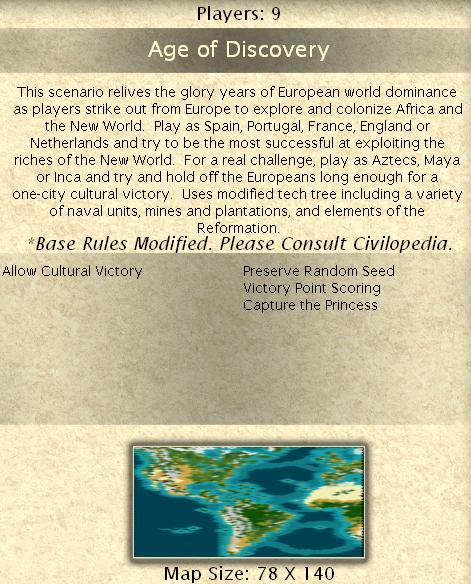 |
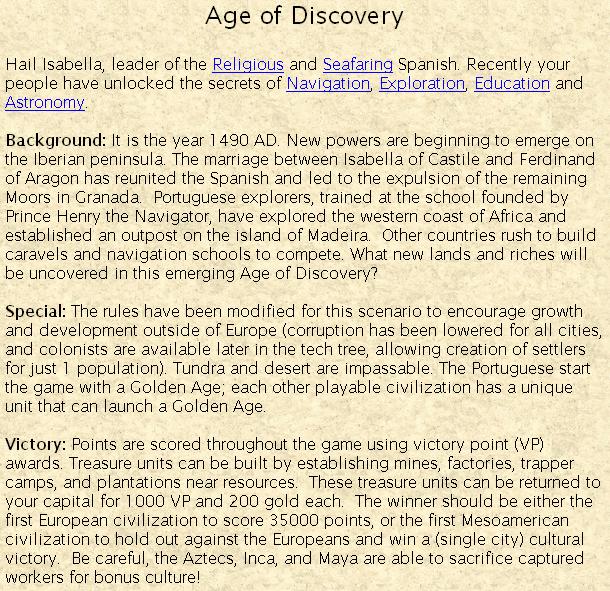 |
Continuing right where Middle Ages and Mesoamerica end, Age of Discovery is a scenario about exploring (and from the European point of view, exploiting) the New World. Of all the Conquests, this was the hardest to program and required the most fine-tuning of playtesting. You have your choice of five European civs (Portugal, Spain, France, England, Netherlands) and three Mesoamerican civs (Aztecs, Maya, Inca). The Iroquois are also a civ in this scenario but are a non-player one. For the European civs, the goal is to race to the Americas and found new colonies there within range of resources like spices, gold, tobacco, etc. If a resource like, say, gold is within the cultural radius of one of your cities, you can build a city improvement called a "gold mine" which produces a treasure unit every 5 turns. This treasure unit can then be picked up by any other unit and carried back to your capital in Europe, where it will give you 1000 victory points and a bunch of gold as well. The scenario has lots of ships though with the enslavement capability, and if you enslave a treasure-carrying ship it passes over into your control. This is very, very entertaining to mess around with, trust me. For the Mesoamercian civs, the goal is to hold out against the technologically superior European civs and try to achieve a one-city cultural victory. This is possible, but difficult since you will need to attack and enslave a lot of enemy units for sacrifice. Scoring is determined by victory points; first to 35,000 wins or whoever has the most after 150 turns is the winner. Mesoamerican civs will have to try and reach 4000 culture in one city, or else REALLY get a lot of victory points from unit kills. The AI still has problems understanding what to do with treasure, but on the whole this scenario really works for me and conveys the spirit of exploration very well. I'd also love to play a multiplayer game on this scenario where everyone agreed not to fight in Europe (since that is not the point of this game) and where the colonial fight for land and treasure was a truly wild ordeal. With three continents to explore, there's a lot here to discover.
Conquest #7: Sengoku
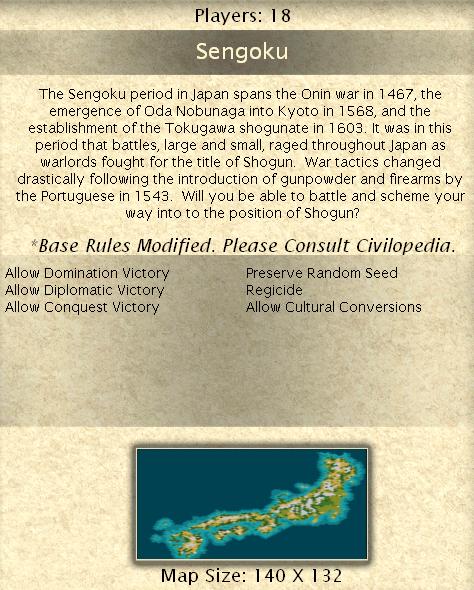 |
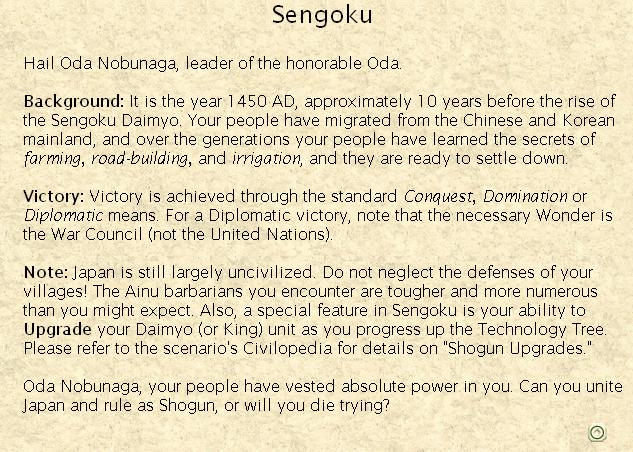 |
Remember all those Japanese units that were included on the PTW disc but had no purpose whatsoever? Here's the reason why they were created. Sengoku isn't so much a scenario as a reworking of the entire main game along the lines of Feudal Japan. For one thing, the map is a freakin' huge rendition of Japan (wait until you play it) packed with 18 different Japanese clans of which most Westerners will have never heard of. Ten of them are playable civs; I would list them here, but the names are so unfamiliar as to be meaningless. You start the game with a single settler, worker, and king unit; of all the Conquests, this one probably most resembles the standard Civ3 game in the starting phase. The big difference is that you have a king unit, or daimyo, to protect which will lose the game for you if it dies. As has been mentioned frequently online though, the daimyo can go through 10 upgrades as new techs are discovered all the way from its starting 2/2/2 to an 11/11/2 status. All of the units in Sengoku are different, mostly designed to reflect the Japanese theme. The tech tree is also unique, and it is quite considerable in length. Sengoku uses no victory point scoring or any other shortcut methods; the game's time limit is a full 540 turns (just like standard Civ3) and requires either a Conquest, Domination, or Diplomatic win. The diplo win is enabled by building a late-game wonder called the War Council which functions in exactly the same way as the United Nations. Also deserving of mention is the ninja units in this scenario, which are invisible, treat all terrain as roads, and have the stealth attack feature. Only one unit can "see" the ninja, so you'd better keep some of them on hand (I understand the AI loves to spam ninjas everywhere). Sengoku certainly could be played as a multiplayer game, but be prepared to spend a long time at it. If there's one thing to remember about this Conquest, just think of it as the standard game set in feudal Japan.
Conquest #8: Napoleonic Europe
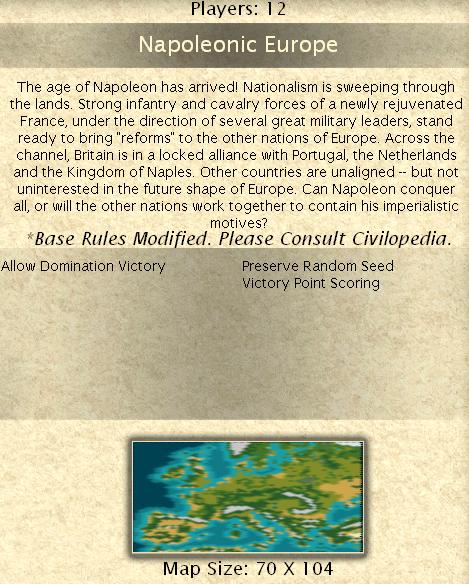 |
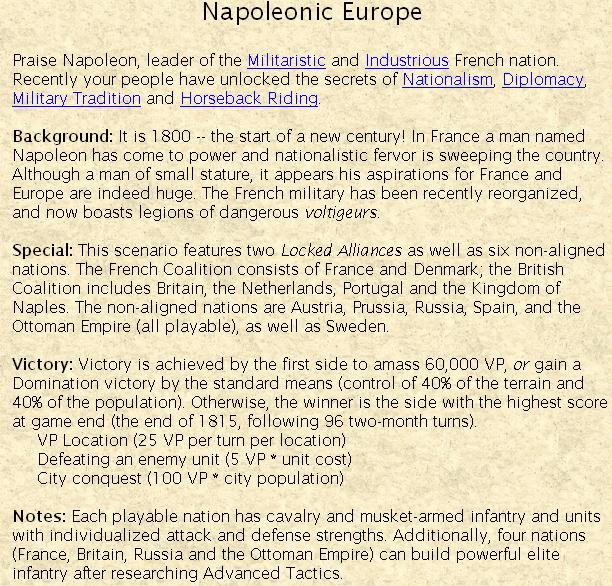 |
Napoleonic Europe is all about battle and conquest. The whole map is full at the very start, and you can't even build settlers in this scenario. There is a tech tree, but researching plays only the smallest of roles in this game. Same for worker actions; most tiles start out already improved and there is no wilderness, so there is relatively little for them to do. This leaves you as the player free to concentrate almost exclusively on fighting, of which there is sure to be a lot. The Conquest has seven playable civs representing the great powers in Europe inh 1800: Britain, France, Austria, Prussia, Russia, the Ottomans, and Spain. There are also a bunch of minor powers (Portugal, Netherlands, Italy, Denmark, Norway, Sweden) who can provide trouble. The game features one locked alliance: France and Denmark versus Britain, Portugal, the Netherlands, and Italy (the usual effect of this is the one-city Dutch being killed by the French in the opening turns of the game). Scoring is done by victory points, with most of it coming from unit kills and city captures; whoever reaches 60,000 first or is ahead after 96 turns is the winner. In terms of balance, France has by far the strongest units, but this tends to simply make France the civ with the biggest target on its back. Diplomacy is actually quite critical to avoid being at war with everyone at once, as Europe usually collapses into non-stop warfare almost immediately, a condition which often lasts the entire game. If you want a game of pure warfare with plenty of room for intrigue, no setup required, this is just about the perfect scenario. Assuming seven players can be rounded up to play all of the major powers, it is also a fantastic multiplayer game. I even had the chance to test this during the beta, and it was a lot of fun. I'll be asking for signups to play this scenario in a couple of weeks, so if you are interested drop me a line. Below is a picture from the game I played, in which I was France and was beating up on Firaxis designer Ed Beach as Prussia at the time the game ended. :)
Conquest #9: World War II in the Pacific
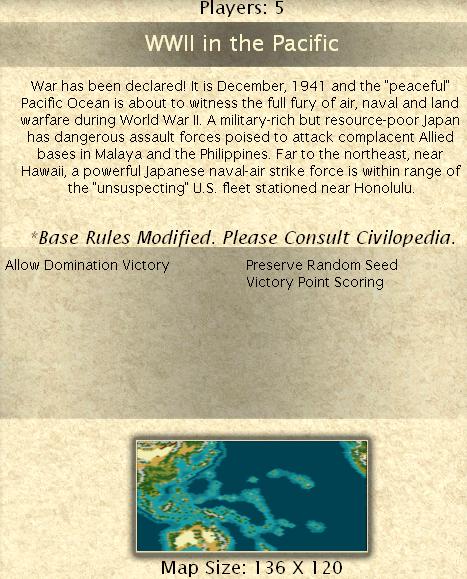 |
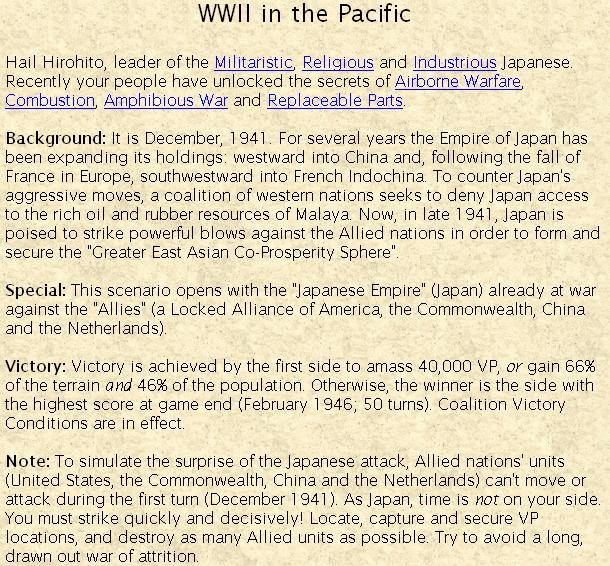 |
World War II in the Pacific is a dream come true for those players who have always longed for an all-out Modern Age war based on naval and air combat. As a rule, Civ3 generally fails to deliver on naval operations, but this scenario is specifically designed to change that. The Pacific Ocean is HUGE, the islands on it literally the tiny dots they are in real life. The game takes the form of a two-sided struggle, with Japan locked into permanent war with a coalition of the United States, China, the British Commonwealth, and the Dutch East Indies (all playable except the Dutch). Scoring is based on victory points, with them being scored for the usual tasks of killing units and capturing cities. Don't expect to spend much time developing cities or researching in this game; it's all about combat. A domination victory is also enabled, but unlikely to be achieved given the short 50-turn time limit to the game. Even 50 turns can take a very LONG time to play, since each civ starts the game with huge amounts of units (especially Japan, which has by my rough count 175 units on the map to start). This can be overwhelming, especially because the BreakAway guys did their homework and used the rename feature to give almost EVERY unit its proper historic name. Thus all the ships have names, the infantry units are named by division, and so on. WWII buffs will be drooling to see this, but it can be overwhelming at first until you get the hang of it. Every game starts in December 1941 with the bombing of Pearl Harbor by the Japanese, which is nicely executed on the whole. From there, it's up to the Japanese to try and grab enough victory points to win before the greater resources of the Allies can be brought into the fight. The AI is still somewhat inept at handling navies and air forces (it doesn't always remember to guard its carriers, for example) and hopefully that still may be improved in a patch. Barring that, if you can get a couple of humans together for multiplayer, this one could be a hell of a fight.
Finally done with the Conquests. The last page is my summary and concluding thoughts on the expansion as a whole.






